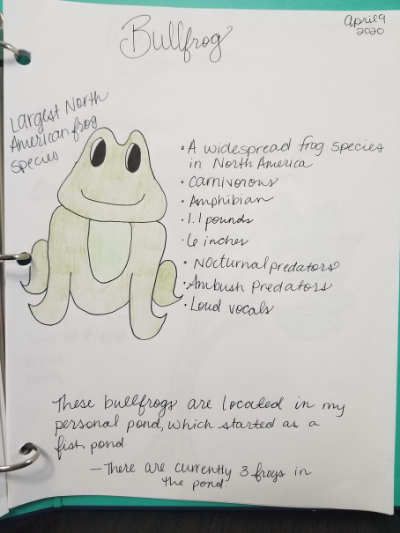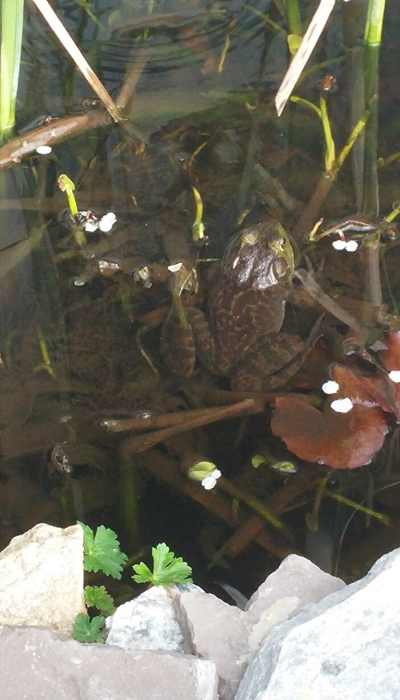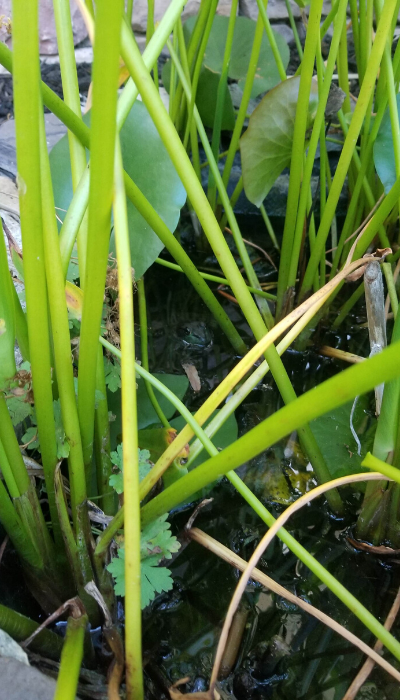Nature Journaling: Observing Animals
By Taylor McConnell, Education Specialist

Tucked away in the back of a cul-de-sac, is a small childhood pond that was supposed to house fish and is now overtaken by pickerel weed and bullfrogs. The first bullfrog is skittish and never seen, only leaving behind ripples in the water. The second bullfrog is next to leave with one big hop and a scream. The third bullfrog stares from the shadows of the overhanging rock and then is the last to disappear.
This scene happens every time someone walks out my front door. I wanted to learn more about bullfrogs, why they are in a smaller pond when there is a creak nearby and why they are so loud at night! I decided to be a scientist, so I grabbed my nature journal and took some notes about what I was seeing.
Observation #1
I notice that the frogs are quick to leave when I walk outside, and it takes them a long time to come back out when I am sitting there. I researched and learned that bullfrogs are often on high alert from predators when I walk by. In their natural habitat their predators are large snakes, snapping turtle and alligators. While I do not have any alligators that live near me, my neighborhood is a corridor to Back Bay National Wildlife Refuge. That mean that we have waterways (creeks and canals) that are connected to the Wildlife Refuge and snakes and snapping turtles are nearby.
After learning this, I decided I did not want to make this a negative interaction for the frogs and turned to two other methods of observation. First, I set my camera out and started to video the overhanging rock, which is where the largest bullfrog seems to be most of the time. Second, I started to observe from the opened window to see if they would come out or if I could hear them.
Observation #2
It looks like the bullfrogs are basking in the sun, like pond turtles do.
I learned that frogs are amphibians and are cold-blooded. When an animal is cold-blooded it means that the animal’s body temperature varies with the surrounding environment. In the afternoon I am seeing the bullfrog come out to warm up from the sun’s heat. If the bullfrogs do not get warm enough, they go into an inactive state, which is seen most often during the winter months.
Observation #3
The bullfrogs get very vocal after the sun sets. We are able to hear them from inside the house.


The bullfrogs are nocturnal, meaning they are most active at night. They also practice ambush predation; meaning they sit still and wait for the prey to come close enough to striking distance and then they pounce.
Bullfrogs also have a series of calls they can make.
Advertisement Call: Bullfrogs get their name from this call because it is loud, low-pitch bellow that sounds similar to a mooing of a cow. This call is used by males to establish territory and attract potential female mates.
Alarm Call: This is a quick chirp, often done by juveniles, as they jump into the water for safety.
Encounter Call: The male will make a short call signaling to other males that they are too close to his territory.

Conclusion
After all this research and documenting, I feel like I have a better appreciation for bullfrogs and scientists too! I learned a lot in the past couple weeks just from observing and researching my frogs. I know what their different calls mean and why they seem so shy. I also know that scientists obviously put in a lot more work than me when they study all the amazing plants and animals we sometimes take for granted. So as you start your nature journal, why don’t you become a scientist! Chose an animal and make some observations like I did. You can find out some of what scientists do when they study animals in the field and learn to appreciate the animals that live all around you every day. I know I did!
***Side note: at the start of the spring they are very skittish and it is really hard to get picture of them. I have the video and the following are pictures from previous springs. The one of all the pickerel weed is latest year (we were finally able to remove the cattail)

References:
CaliforniaHerps.com (2020) Sounds of the American Bullfrog.www.californiaherps.com/frogs/pages/l.catesbeianus.sounds.html
National Geographic (2020) Bullfrogs.https://www.nationalgeographic.com/animals/amphibians/a/american-bullfrog/
Virginia Herpetological Society (2020) American Bullfrog.http://www.virginiaherpetologicalsociety.com/amphibians/frogsandtoads/american-bullfrog/american_bullfrog.php